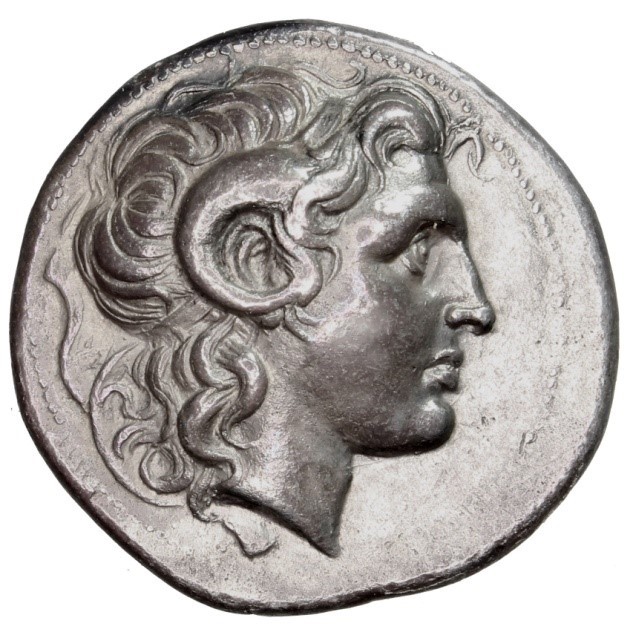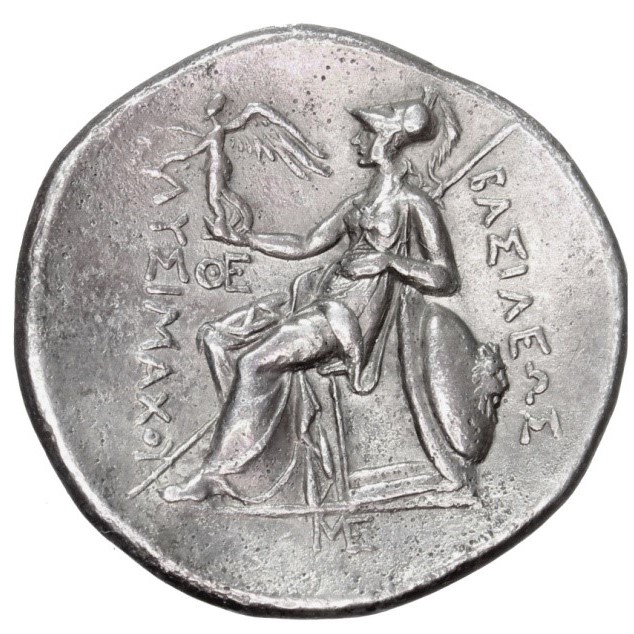Acquisition number: 2018.01
Obv.: Diademed head of the deified Alexander r., with horn of Ammon.
Rev.: Athena Nikephoros seated l., holding Nike, left arm resting on shield, spear behind. Legend: ΒΑΣΙΛΕΩΣ ΛΥΣΙΜΑΧΟΥ (‘of King Lysimachos’); ΘΕ monogram to inner left, ΜΕ monogram in exergue.
Title: Tetradrachmon of Lysimachos - 2018.01
Acquisition number: 2018.01
Author or editor: Peter Londey
Culture or period: Hellenistic.
Date: 297 - 281 BC.
Material: Metal - Silver
Object type: Coins - Greek
Dimensions: 16mm (w)
Origin region or location: Türkiye
Origin city: Alexandria Troas.
Display case or on loan: 5
Keywords: Coin, Greek, Macedonian, tetradrachmon, Lysimachos, Alexander, Ammon, Athena, Nikephoros, Nike, Alexandria Troas
A. R. Meadows, The Earliest Coinage of Alexander Troas, The Numismatic Chronicle 164 (2004), 47.
M. Thompson, ‘The Mints of Lysimachus’, in C.M. Kraay and G.K. Jenkins, eds, Essays in Greek Coinage presented to Stanley Robinson (Oxford, Clarendon Press, 1968).
Meydancikkale = A. Davesne and G. Le Rider, Le trésor de Meydancikkale (Cilicie Trachée) (Berkeley, University of California, 1980), 2657.
N. Davis and C.M. Kraay, The Hellenistic Kingdoms: Portrait Coins and History (London, Thames and Hudson, 1973), 22, 142.
2018.01
Tetradrachmon of Lysimachos
Silver 17.01 g. 16.7 mm. 297-281 BC.
Obv.: Diademed head of the deified Alexander r., with horn of Ammon.
Rev.: Athena Nikephoros seated l., holding Nike, left arm resting on shield, spear behind. Legend: ΒΑΣΙΛΕΩΣ ΛΥΣΙΜΑΧΟΥ (‘of King Lysimachos’); ΘΕ monogram to inner left, ΜΕ monogram in exergue.
Alexandria Troas mint.
Meadows Earliest 11, dies O8/R18; Thomson, Meydancikkale 2657 (same obverse die).
From the collection of José Miguel Márquez del Prado. Ex Roma E-Sale 21 (31 October 2015), lot 211.
See NC 2004, p. 47; A. R. Meadows, The Earliest Coinage of Alexander Troas.
This coin was struck some 30 years after the death of Alexander the Great in 323 BC. At his death, his kingdom stretched from Greece to NW India and covered an area of 5 million sq km. This area was divided between his generals.
Lysimachos (305-281 BC) was a senior general in Alexander’s inner circle. He took control of the area known as 'Thrace', with his capital at the new city of Lysimacheia on the Gallipoli peninsula.
His first coinage included issues of silver tetradrachms in the name of Alexander – these have the head of Herakles wearing the lion skin, Zeus, seated, on the reverse, with the legend AΛEΞANΔΡΟY ('of Alexander'). Such coins are often referred to as struck ‘in the name and types of Alexander the Great’.
In 301 BC Lysimachos (together with Seleukos I and Ptolemy) was on the winning side in the Battle of Ipsos (Phrygia), a battle that was to be significant for the emerging Hellenistic world. Following this battle many of the regional kings ceased striking coins ‘in the name and types of Alexander the Great’ and used their own names, portraits and titles as king.
Lysimachos differed from this pattern in that his coins bore the legend ΒΑΣΙΛΕΩΣ ΛΥΣΙΜΑΧΟΥ (‘of King Lysimachos'), but they did not use his portrait. The obverse portrait is considered to be Alexander with the horn of Ammon. While visiting Egypt, Alexander is said to have made a journey to the oracle of Zeus Ammon at Siwa.
See N. Davis and C.M. Kraay, The Hellenistic Kingdoms: Portrait Coins and History (London, Thames and Hudson, 1973), 22, 142.
It is important to note that this coin was minted in Alexandria Troas. This city was established by the Macedonian general Antigonos Monophthalmos. After the battle of Ipsos this town is thought to have become part of the kingdom of Lysimachos and was renamed by the king to honour Alexander the Great (Strab. 13.1.26).
A. R. Meadows published a study of the early output of the Alexandria Troas mint in 2004. According to that study this coin is one of the numbered Lysimachos issues from that mint (number 11 out of 25); the obverse die is the same as one reported in a standard reference list (Meydancikkale 2657). See Meadows, Numismatic Chronicle 2004, p. 47 (some of this inferred from Strabo).
This coin is important because it is thought that it may present a realistic portrait of Alexander. It had been authorized by Lysimachos, who had been his friend and companion, and was issued within 40 years of Alexander’s death.
It is important also because this powerful image of Alexander marks the beginning of a tradition of portraiture on coins that continues to the modern day. It was produced 300 years after the invention of coinage, but until this time the insignia of a state or the head of a deity had been regarded as the appropriate subject to be depicted on a coin, as we see with the Athenian tetradrachmon (2014.01). This head of Alexander was copied in later issues for hundreds of years.
Purchased by the Friends of the ANU Classics Museum in memory of Jill Greenwell.
A. R. Meadows, The Earliest Coinage of Alexander Troas, The Numismatic Chronicle 164 (2004), 47.
M. Thompson, ‘The Mints of Lysimachus’, in C.M. Kraay and G.K. Jenkins, eds, Essays in Greek Coinage presented to Stanley Robinson (Oxford, Clarendon Press, 1968).
Meydancikkale = A. Davesne and G. Le Rider, Le trésor de Meydancikkale (Cilicie Trachée) (Berkeley, University of California, 1980), 2657.
N. Davis and C.M. Kraay, The Hellenistic Kingdoms: Portrait Coins and History (London, Thames and Hudson, 1973), 22, 142.

